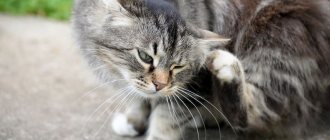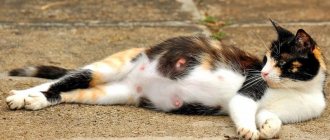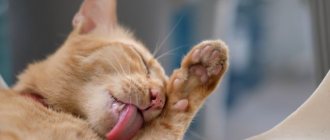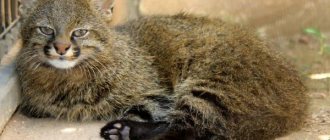What will you learn from the article?
- Russian cat breeds
- Key Features
- Russian blue cat
- Siberian
- Neva Masquerade
- Don Sphynx
- Peterbald
- Kurilian Bobtail
- Ural rex
- Altai blue-eyed
- Ussuri cat
History claims that cats spread across the territory of the Russian Federation simultaneously with the settlement of areas by tribes. Only towards the end of the 20th century did targeted work on breeding cat breeds begin; disputes about the belonging of some types of breeds to Russian selection are still ongoing today.
A cat worth its weight in silver
Philip Budkin.
Girl in front of a mirror. 1848. National Art Museum of the Republic of Belarus, Minsk, Belarus The first cats were brought by sailors to Russia in the pre-Christian era. Exotic animals were a valuable commodity: the value of a cat until the 15th century was comparable to the value of a healthy arable animal - an ox. They paid for the cat in hryvnias - silver bars of 205 grams. If you killed someone else's animal, accidentally or maliciously, you had to pay its owner compensation - one hryvnia and a healthy animal in return for the killed one.
“If someone kills a dog or a cat, the blame is on the hryvnia, and the dog belongs to the dog, and the cat belongs to the cat.”
Collection of laws “Metropolitan Justice”, XIII century
Cats in pagan Rus'
Everyone knows about the veneration of cats in Ancient Egypt. But exactly when these tailed friends of man appeared on Russian soil is unknown. It is assumed that cat paws set foot on our land around the 11th century. Although on the southern borders, which now belong to Ukraine, cats may have been found back in the 7th or 8th century. Maybe even earlier.
Initially, cats were worth almost their weight in gold. Which is not surprising, because the animal was still rare, but it had a lot of benefits. In those days, invasions of rats and mice were a real disaster that could doom people to starvation.
Cats were the real and almost the only salvation for grain storage facilities. And at the same time, it was also a means to reduce epidemics that were spread by numerous rodents.
According to some information, cats were brought to us by sea, from the southern borders of the country. But according to another version, cats have always lived here, these are famous wild cats. From which came Russian cats of the Siberian breed.
The only animal in the temple
Ivan Bilibin. Scientist cat. Frontispiece to “The Tale of the Golden Cockerel” by Alexander Pushkin. 1910. Private collection
In the Catholic countries of medieval Europe, cats were considered minions of witches and servants of the devil - especially black ones - and were burned at the stake. In Orthodox countries, they were treated exactly the opposite. In Rus', a cat was considered a pure animal. Of all the animals, only she was allowed to enter the temple. In addition, cats saved the bins of churches and monasteries from rodents, which provided them with the patronage of priests for many years.
Signs about cats
There are many signs and superstitions about cats. Initially, the cat was considered a helper and keeper of the hearth. Which is not surprising, given the large role of the cat in maintaining the well-being of the family.
The cat was usually allowed in first when entering a new home. At the same time, it was believed that the cat was associated with evil spirits. Which could have a negative impact on people’s attitude towards this cute animal.
Especially for black cats. I will accept that if a black cat crosses your path - expect misfortune, it is known to everyone. Although, on the other hand, there was a belief that black cats in the house would bring misfortune not to the owners, but to intruders who would break into the house.
Cats also became heroes of many famous Russian fairy tales. Do you know signs and tales about cats?
Portrait of a royal cat
Vaclav Hollar. An authentic portrait of the cat of the Grand Duke of Muscovy. 1663. National Library of France, Paris, France
Cats also took root at court. They lived in the royal chambers, and even painted portraits of some of them. In 1661, the Dutch artist Frederic Moucheron created a portrait of Tsar Alexei Mikhailovich's cat. The Hermitage houses an engraving made from this drawing by the Czech artist Vaclav Hollar. For a long time it was believed that it was created during the time of Ivan the Terrible, but this was refuted by collector and art historian Dmitry Rovinsky. In 1884, he described the engraving in his book “Materials for Russian Iconography”: “This leaf is very rare. Chizhev saw a copy of this cat in Dresden, without a year, cut off from the bottom, and therefore attributed it to Tsar Ivan the Terrible; Snegirev repeated this mistake in his Popular Pictures.”
To protect barns and deter mice
Vyacheslav Schwartz. Scene from the home life of the Russian Tsars (Chess game). 1865. State Russian Museum, St. Petersburg
Alexei Mikhailovich's son Peter I considered cats to be animals that could be useful. In one of the decrees, he ordered “to have cats in the barns, to protect them, and to intimidate mice and rats.” Peter I's favorite cat was named Vasily. The Tsar took it in 1724 from the house of a Dutch merchant who traded in Vologda - Peter the Great often visited him.
Ratcatcher cats from Kazan
Pavel Fedotov. The Major's Matchmaking, or Correcting Circumstances by Marriage. 1848–1849. State Tretyakov Gallery, Moscow
The cat campaign against pests was continued by Empress Elizaveta Petrovna. In 1745, the Empress ordered 30 kept (castrated) rat-catching cats to be sent especially for the Winter Palace. The cats were brought from Kazan: it was believed that Kazan cats were skilled rodent hunters.
“... Having found in Kazan the best and largest thirty cats of the local breeds, convenient for catching mice, send them to St. Petersburg to the court of Her Imperial Majesty... And if anyone has such stored cats, they would be announced for speedy departure the provincial chancellery, of course, from publication within three days, fearing for failure to announce who has them, and who does not announce them, a fine according to the decrees ... "
“Decree on the expulsion of cats to the courtyard,” 1745
Art gallery security guards
Nikolai Bodarevsky. Favorite. 1905. Private collection
Catherine the Great did not like cats, but she could not do without them. The Empress not only did not eliminate the cats from the Hermitage, but also gave them a new status as “guards of art galleries.” The Empress ordered: “...to divide the cats into indoor and outdoor cats, and in order to know the number of the first and second, entrust keeping records.” Those who were good at catching mice and at the same time were good-looking were taken into the “room” ones - these were mainly Russian Blue cats.
Kurilian Bobtail
The Kurilian Bobtail is another breed that belongs to the aboriginal group. A distinctive feature is a fluffy and short pom-pom tail.
Cats have a bright and memorable appearance:
- strong and compact build;
- powerful legs, heavily covered with hair;
- a lush mane on the neck and abundant fur throughout the body;
- a muzzle with the features of a wild animal;
- wide powerful cheekbones;
- piercing look.
There are two varieties of the breed – shorthaired and semi-longhaired. The color can be varied. The standard does not allow such colors as chocolate, lilac, cinnamon, fawn.
Kurilian Bobtails not only have an original appearance, but also a unique character. In behavior and type of temperament, they are more like dogs. Cats of this breed are very loyal to their owners and very obedient. Only one person is considered the owner. They treat other family members calmly and friendly. Their easy-going nature allows them to coexist peacefully with other pets, even dogs.
Cats in Russian proverbs
Ivan Gorokhov. At the convalescent bedside. 1886. Buryat Republican Art Museum named after Ts.S. Sampilova, Ulan-Ude
By the end of the 18th century, cats ceased to be “piece goods”. Now they lived not only at churches and in the houses of rich people, but also in the huts of peasants. This was also reflected in folklore. In 1853, the Russian naturalist, writer and linguist Vladimir Dal published a two-volume book “Proverbs of the Russian People” - cats were mentioned in 75 of them.
It’s not all about Maslenitsa; there will be Lent too. Even the cat might jump off the stove. Get out of the stove, cat: you need to dry them. The dog eats crumbs under the table, and the cat waits for spilled milk. If you kill a cat, you won’t see any luck in anything for seven years. He, like a cat, always falls on his feet.
Fact No. 2: the first mention of seals in the chronicles is related to the fact that they were... eaten.
Sadly, seals are most often mentioned in written sources as food. Of course, in ordinary life they were not eaten - this happened only in an emergency: during famine. The Novgorod First Chronicle describes the terrible events of 1230 as follows: “and the troupe was circumcised by Judahou. and drowsii koninou, psinou. cats. nb those osochishche tako tvoryahou” (NPL, 113 vol.).
The fact that the townspeople started eating cats shows that they had no other food left. This terrible mention (probably the oldest in written sources) dates back to the middle of the 13th century, when the text of the chronicle was written. In general, cat meat was considered unclean, and eating it, according to medieval scribes, was a sign of savagery. Thus, in the Laurentian Chronicle one can find the following description of the wicked tribe: “I eat every kind of filth. mosquitoes and flies. kotki (this form of the word was used on a par with the familiar “cat.” – Ed.), serpent. and a dead man is not a cellar” (LL 1377, 85 a (1096)).
“Like a sport - who has the fatter cat”
Boris Kustodiev. Merchant's wife having tea. 1918. State Russian Museum, St. Petersburg
In cities, cats “worked” mainly in markets. They lived freely and well-fed. Journalist Vladimir Gilyarovsky wrote in his book “Moscow and Muscovites” that the cats of Okhotny Ryad were especially well-fed. Local merchants protected valuable custodians of goods. They were even allowed to sit on the counters during breaks between hunting rodents.
“...The first thing they ordered was to have cats in all shops. But cats were already in most shops. It was like a sport to see who has the fatter cat. Well-fed, huge cats sat on the counters.”
Vladimir Gilyarovsky, “Moscow and Muscovites”
Fact No. 4: in the 14th century, seals were valued several times more expensive than cows and on a par with dogs.
The so-called “Metropolitan Justice”, a legal monument of the 14th-15th centuries, lists the following fines for theft:
“...for a cat 3 hryvnia, for a dog 3 hryvnia, for a mare 60 kun, for an ox 3 hryvnia, for a cow 40 kun, for a third 30 kun, for a hollow half a hryvnia, for a calf 5 kun, for a boran nogata, for a pig nogot, for for a sheep 5 kun, for a stallion hryvnia, for a foal 6 nails”[5].
If we consider a kuna equal to 1/50 of a hryvnia [6], then 3 hryvnia = 150 kuna, which is almost 4 times more than what was demanded for a cow. Even if we take the earlier “rate” of the 11th century - 3 hryvnia = 75 kunas, then this amount is almost 2 times more than the fine for a cow. Surprisingly, the cat was valued as highly as the dog and ox, which were much more closely involved in the human economy. Such a fine looks even more strange if we take into account our assumption that cats survived in ancient Russian cities on their own and were “yard servants”. Maybe the church representatives had some special purebred cats living with them? The source says nothing about this.
Cats of besieged Leningrad
Pavel Kondratyev. Street of the besieged city (fragment). From the series “Blockade”. 1942. Museum of Fine Arts of the Republic of Karelia, Petrozavodsk
During the years of the siege, almost all Leningrad cats either died or were eaten. Therefore, rats quickly multiplied in the city. In April 1943, 5 thousand smoky cats were brought to Leningrad from Yaroslavl, and then another train of cats from Siberia. Soviet writer Leonid Panteleev wrote in his diary during the siege: “A kitten in Leningrad costs 500 rubles.” For comparison: a kilogram of bread was bought by hand for 50 rubles, and a watchman earned 120 rubles. The four-legged fighters were sent to museums and basements of surviving residential buildings. After some time, they cleared the city of rodents.
Cat as an attraction
Ekaterina Kachura-Falileeva. At the samovar. 1st half XX century
Cats still “work” in the Hermitage - not in the exhibition halls, but in the courtyards and basements. Each cat has a veterinary passport, a bowl and a basket for sleeping. In 2016, the British publication The Telegraph included the Hermitage cats in the list of unusual attractions that you must see if you come to St. Petersburg.
“There are only 50 cats, I set this limit myself. They live in the yard and in basements. We give “extra” cats to good hands. They know their habitats in the basements; there is no need to guide them. We have interviews and filming about cats no less often than about Rembrandt.”
Director of the Hermitage Mikhail Piotrovsky, Literaturnaya Gazeta, 2014
How cats populated Russia. Where did the cat come from?
The results of the latest genetic studies conducted by scientists from a number of countries allow us to take a fresh look at the well-known data on the distribution of the domestic cat across the territory of modern Russia.
The cradle of civilization is a “cat’s cradle” (once again about the concept)
Evidence obtained during archaeological excavations in recent years suggests that the domestication of the cat occurred approximately 9-10,000 years ago in the Middle East in the Fertile Crescent region (an area stretching from modern Turkey to North Africa and from modern Iran to Iraq). during the transition of man to a sedentary lifestyle and with the emergence of agriculture, when small settlements and the first cities began to appear. Kittens for sale Cat nurseries Cat food Atlas of cat breeds
The findings of archaeologists were confirmed by the latest genetic research published in 2007. The results of genetic studies completed by March 2008 confirmed previous findings that all living domestic cats are descendants of the domesticated Middle Eastern wildcat (Felis silvestris lybica), and no other subspecies of Felis silvestris contributed to the formation of the domestic cat Felis silvestris catus as a subspecies. The researchers came to the conclusion that the spread of cats from the ancient center of domestication went along trade routes between ancient civilizations. As a result of these studies, scientists have discovered interesting relationships between individual cat breeds and populations, which can be traced back to human history. Based on the fact that “cats from Turkey had the greatest gene diversity of any other cat,” the scientists concluded that “cats from Turkey were the earliest domesticated,” with particular emphasis on Anatolia. Genetic research continued and new results were published in June 2009. According to the researchers, “over time, wild cats, which were more tolerant of human-dominated environments, began to spread throughout settlements throughout the Fertile Crescent. Selection in this new niche was mainly based on tameness, but the struggle for existence between cats continued to influence their evolution and limited their compliance” in relationships with people…. A key factor in the domestication of the Middle Eastern wildcat (F. s. lybica) was that “people may have even encouraged cats to hang around when they noticed them killing mice and snakes.” The appearance of this subspecies turned out to be no less significant: “large eyes, a truncated muzzle and a high, round forehead” - features that, as is known, evoke in a person a desire to caress a creature with such features and surround it with tender care. Probably driven by these feelings, “some people brought home kittens, simply because they thought they were charming, tamed them, giving cats a place at home.” I think, however, many people are interested in the question of why the Middle Eastern wildcat (F. s. lybica) became the only subspecies of wildcat that was domesticated by humans. The researchers explain this by saying that the Middle Eastern wild cat (F. s. lybica) had an advantage over other subspecies of small wild cats in being the first to be adjacent to the first human settlements. As agriculture spread from the Fertile Crescent, the Near Eastern wildcat (F. s. lybica) filled the same specific niche in each region it entered, thereby closing the door to human habitation for native wildcat populations. An ivory figurine discovered in Israel, some 3,700 years old, confirms that the presence of domestic cats in homes and settlements in the Fertile Crescent was common before they were brought to Egypt. Due to the fact that to date there are no other studies that shed light on the origin of the domestic cat or refute the above-mentioned conclusions, when considering data on the distribution of cats throughout Russia, I will rely on the concept of the Middle Eastern origin of the domestic cat. The main advantage of this concept is the main conclusion that follows from the results of the above-mentioned studies: the domestic cat (Felis silvestris catus), like any other domestic animal, cannot exist separately from humans, who from the very beginning of civilization, migrating across the planet, took everywhere her with you as a faithful assistant, the darling of the family and the keeper of the hearth.
Shorthair cats
A journey of ten thousand years With the development of agriculture and the emergence of surplus food, the population of ancient cities began to increase sharply, which led to the need to colonize new territories. In the 9th-7th millennium BC. e. The settlement of Proto-Indo-Europeans from the Fertile Crescent area increased sharply, which took place on small ships along the banks of rivers, lakes and seas. At the same time, it was established that even then cats swam along with people on sea vessels, protecting ships and food supplies from rodents. This was evidenced by the discovery of the remains of cats on the island of Cyprus, where cats could only arrive on ships along with people, and, therefore, were already domesticated. The colonization of new lands was a constant process that lasted for millennia and was determined both by population growth and the development of agriculture. According to Academician B. A. Rybakov, “from the middle of the 5th millennium BC. e. the settlement of Indo-European farmers in a northern direction is observed.” This settlement is called by some authors “agricultural settlement.” By 3000-2500 BC. e. the north of Europe was almost completely populated by Indo-European tribes, and the need to develop new arable lands pushed the Indo-European colonizers further east. I assume that the appearance of cats on the territory of modern Russia is associated with the appearance of Slavic tribes here in ancient times. As the authors of “History of Russia” write: “The Slavs, according to most historians, separated from the Indo-European community in the middle of the 2nd millennium BC. e. The ancestral home of the early Slavs (Proto-Slavs), according to archaeological data, was the territory to the east of the Germans: from the Oder River in the west to the Carpathian Mountains in the east. A number of researchers believe that the Proto-Slavic language began to take shape later, in the middle of the 1st millennium BC. e." (A. S. Orlov, V. A. Georgiev, N. G. Georgieva, T. A. Sivokhina, “History of Russia”, 2008). The first mentions of the Slavs are found in written sources in the middle of the 6th century. n. e., when Slavic tribes settled across the East European Plain. “During the era of the Great Migration of Peoples (III-VI centuries AD), which coincided with the crisis of slave civilization, the Slavs mastered the territory of Central, Eastern and South-Eastern Europe. They lived in forest and forest-steppe zones, where, as a result of the spread of iron tools, it became possible to conduct a settled agricultural economy" (A. S. Orlov, V. A. Georgiev, N. G. Georgieva, T. A. Sivokhina, "History Russia”, 2008), which determined their way of life and living conditions. In the VI-VIII centuries. In the northern zone of Eastern Europe, the Slavs were dominated by short-lived settlements due to shifting agriculture. The rapid development of arable farming using horses led to the appearance at the end of the 8th century. small villages, and in the 9th century, as ancient Russian chronicles report, ancient cities began to appear in Northern Rus': Izborsk, Ladoga, Novgorod, Polotsk and Smolensk, which, first of all, were places of settlement for merchants and artisans, and also performed defensive functions .. This process continued in the X-XI centuries. with the emergence of such cities as Pskov, Vitebsk, Golotichesk, Drutesk, Logozhesk, Rshu and Yuryev.
' So, the spread of the cat across the East European Plain occurred simultaneously with the spread of the East Slavic tribes. According to the data presented by V. Karpov in his work “Treatise not only about the cat” (yearbook “On Land and Sea”, 1987), during archaeological excavations in the ancient cities of the Northern Black Sea region - Panticapaeum, Tanais, Phanagoria and others, The remains of cats were discovered that date back to the 1st century. BC e.-I century n. e.. V. Karpov writes that these cats were inhabitants of large and rich cities of the Roman Empire. “Archaeologists have not found any traces of cat habitation in rural settlements. The only exception is the find in the Scythian settlement, which is called the Kamensky settlement, but it was the capital of the steppe Scythians on the left bank of the Dnieper, opposite modern Nikopol. In Scythian Naples, the capital of the Crimean Scythians, the remains of cats were not found.” Further, the author writes: “This indicates that the ancient Greeks, trading with the Scythians in gold jewelry, utensils and all kinds of living creatures, at the same time protected the rarest domestic cats for themselves.” However, in the light of new data on the domestication of cats, this is most likely explained by the fact that cats were not needed by the Iranian-speaking Scythian nomads, but by the so-called Scythian plowmen, who, according to some researchers, were a conglomerate of Slavic and Scythian tribes, engaged in shifting agriculture, when they constantly had to move to new arable lands, had not yet led a truly sedentary lifestyle. But let’s continue to quote the author of “Treatise not only about the cat”: “The advancement of the domestic cat from the shores of the Black Sea to the harsh north was slow. Thus, the remains found by archaeologists on the territory of the Kirovograd, Odessa and Cherkasy regions date back to the 2nd-5th centuries of the new era. But again, only one copy in three settlements. However, already in excavations dating back to the 6th-7th centuries, archaeologists recorded the appearance of a cat in Pskov, the Baltic cities and near Yaroslavl. In the 7th-9th centuries, this beast found its way to the region of Staraya Ladoga and the Middle Volga region, and by the 13th century it spread throughout Rus', as evidenced by archaeological finds again. In the Yaroslavl Volga region, archaeologists uncovered more than 600 burial mounds, and 200 contained the remains of sacrificial animals... but cats were found only in two mounds where women were buried.”
From the above, we can conclude that in the 6th-9th centuries, with the advent of the first urban settlements among the Eastern Slavs, cats began to appear in them, which in some certain cases were buried along with their mistresses, while cats were neither sacrificial animals nor food supplies for the feast of their mistresses in the other world. Here I recall the content of an interview with Jean Denis Vigne, vice-president of the Scientific Council of the National Museum of History in Paris, published in April 2004 in the American magazine Science, who reported that in a Neolithic settlement of about village of Shillourokambos (9-7 thousand BC) a burial dating back to 7 thousand BC was discovered. e., with two skeletons: a man and a cat. The sex of the person could not be determined due to damage to the skeleton, but judging by the decoration and the number of objects found, this person played a prominent role in his environment. The cat's burial was located symmetrically to the first. The cat was killed, presumably to be buried with its eventual owner or owner. The heads of both skeletons were directed towards the west, which clearly indicates that cats had a certain, most likely ritual, significance in the life of the ancient inhabitants of Cyprus. In connection with the above, let's try to draw several parallels with the history of the Eastern Slavs. Based on archaeological data, Russian historians have determined that the Eastern Slavs, or, most likely, their ancestors, the Proto-Slavs, treated cats as totem and, possibly, cult animals, and images of cats and other felines served them as amulets. Considering the differences between the cultural and religious traditions of the agricultural era from previous ones, and what connects them and “continues the thousand-year traditions of the hunting society,” this is what Academician of the Russian Academy of Sciences Boris Aleksandrovich Rybakov writes in his fundamental work “The Paganism of the Ancient Slavs”: “An interesting section of zoomorphic plasticity is lids of large vessels. Very often they were designed in the form of heads or even whole figures of animals. The heads of bears, cats or lynxes, deer, goats, figures of a dog and a leopard are known. The preference given to predators is understandable: the lid should protect the supplies placed in the vessel from all possible thieves. The cat will protect you from mice, and the bear will also warn people who encroach on the contents of the storage facility. The simplest magical calculation is evident in these naive measures to protect the farmer’s family values.” Settling throughout Eastern Europe, the Slavs moved mainly along large rivers, which at that time served as almost the only transport arteries for forest and forest-steppe regions. As Professor K.V. Bazilevich writes: “Byzantine writers of the 7th century. they mention Slavic one-tree boats, in the construction of which the Slavs were considered great masters. The high seafaring skill of the Eastern Slavs is evidenced by the fact that Ant Dobrogast was invited by Byzantium to command the Black Sea flotilla. ... Greek sources speak of a great Slavic campaign against Constantinople in 626, and the latest research shows that this campaign was carried out precisely by the Eastern Slavs.” The Tale of Bygone Years also reports on other sea voyages. Under Prince Igor, Russian squads on more than 500 ships sailed the Black, Azov and Caspian Seas, dragging ships from the Don to the Volga and back. The size of the largest ships - rooks - allowed them to accommodate more than 40 people. Therefore, I think we should not exclude the possibility of the presence of cats not only on small ships on which people and household belongings were transported when moving to new lands convenient for arable farming, but also on the fighting boats of the Eastern Slavs. This assumption confirms the guess that cats, which do not accept a nomadic lifestyle, moved with their owners on ships, perceiving the latter as a home, and in the confined space of small-sized ships, domestication processes occurred faster. I will also add that in the burials of the Eastern Slavs of that distant era, it was typical to orient the location of the skeleton with its head to the west. Despite the colossal gap in time separating the burial in Cyprus and the burials on the banks of the Volga, between them there is clearly visible, if not similarity, then continuity of the Proto-Indo-European tradition, and, most likely, in the burial discovered in Cyprus in the 9th-7th millennium BC. e. the skeleton belonged to a woman, as was the case with the two mentioned mounds of the 10th century AD. e., discovered in the Yaroslavl Volga region. There is a green oak near the Lukomorye... It is believed that in the 10th–13th centuries in Russia the cat continued to be a rare “beast”.
At the same time, a vast layer of Russian folklore consists of folk tales, proverbs and beliefs associated with cats and cats. Before the introduction of Christianity in Rus', the Slavs revered pagan gods. The almighty god of the underworld was Veles, the patron saint of livestock, wealth and all animals. Veles’s companion was the Cat, whose name was “Bayun” (otherwise Bai or Bayunok), and many customs and rituals were associated with him. After the introduction of Christianity in Rus', pagan beliefs and rituals were banned. But thanks to oral folklore, the name Kota-Bayun has survived to this day. A lot of fairy tales and beliefs associated with cats and cats, in which echoes of pagan myths are preserved, were recorded by the Russian researcher of folk art, literary and folklore historian Alexander Nikolaevich Afanasyev (1826-1871): “Russian folk tales know the fabulous cat-bayun, who is exactly like this the epithet of the sea is given, like other personifications of rain clouds, and which legends place in close connection with the wonderful mill - the emblem of the thunderous roar. Near this mill there is a golden pillar, a golden cage hangs on it, and a bajun cat walks along the pillar: it goes down - it sings songs, it goes up - it tells fairy tales... The voice of the Bayun cat can be heard for several miles; His power is enormous: he strikes his enemies to death or with his songs sends an irresistible sleep over them... Whoever kills a cat, according to the peasants, will have no luck in anything for seven years.” Even the good spirit-protector of the hearth - the brownie - turned into a cat when he wanted to warn the owners of danger and ward off trouble. Until now, in our everyday speech we often repeat the name Kota-Bayun, since many words of the modern Russian language are derived from it: “fairy tale” - fairy tale, “krasnobay” - talker, “pribautka” - joke, “cradle” - rock a child to a lullaby. All this, in my opinion, is indirect evidence that cats were not only well known in Ancient Rus', but were also widespread. The earliest written mention of a cat dates back to 1230, when the Novgorod chronicles tell of a famine during which they ate carrion, horse meat, dog meat and cat meat. Of great interest are the finds made in Old Ryazan, where during archaeological excavations in a layer dating back to the period of the conquest of Ryazan by Batu in 1237, the remains of 7 cats were found, and in the home of a bone carver, a bone plate for binding a handwritten book, carved in in the form of a stylized image of a cat. The next interesting discovery was made during excavations of the historical layer from the time of a strong fire, which occurred during the capture of Kiev in 1240 by the Tatar-Mongols led by Batu (aka Batu Khan), when the remains of a girl with a key were discovered on the threshold of a barn with a cat locked inside . One can imagine this eloquent episode of a great tragedy, when a child rushed to save his pet, a cat, but a burning beam fell, crushed the girl and they both died in the flames of the fire. Zarine Lorentsovna Arushanyan
Read part 2. How cats populated Russia.
European Shorthair or Celtic? Cats
History of the origin and distribution of cats
How cats populated Russia. Where did the cat come from?











